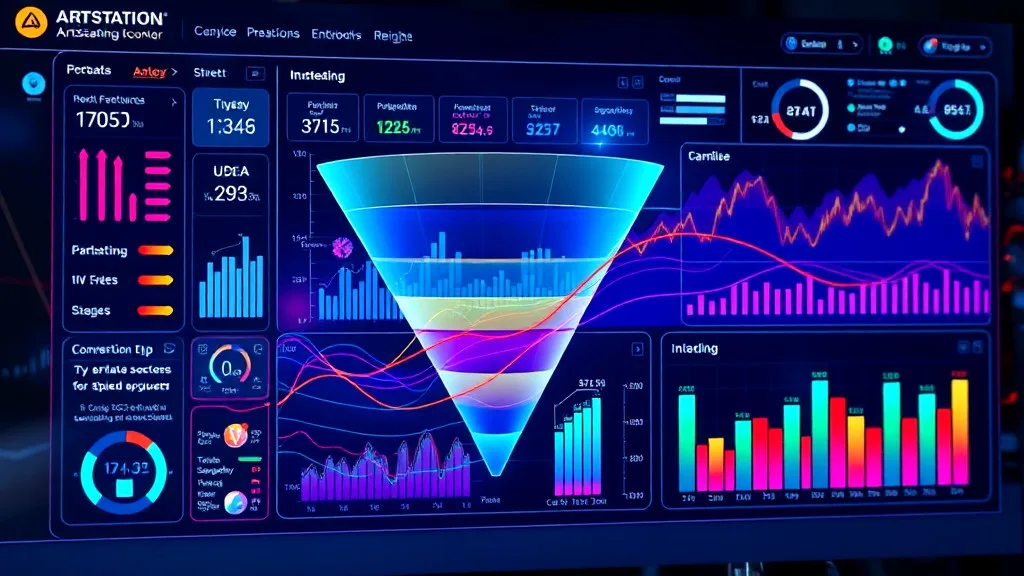Welcome to our guide on sales funnel reports!
Ever wondered how a sales funnel works? Imagine it as a path guiding potential customers from their first interaction to becoming loyal buyers.
Our sales team knows that understanding this journey is crucial. It helps us pinpoint where we shine and where we slip up.
Each sales funnel stage—from awareness to action—requires unique tactics to keep prospects moving forward. That’s where sales funnel reports come in.
These reports give us insights into our sales process and help fix any leaks. They also highlight how our sales reps are performing.
Ready to explore how a great sales funnel can transform your strategy and boost your success? Let’s get started!
Key Takeaways
- Sales funnel reports are essential for spotting where we excel and where we slip up.
- Key sales funnel stages include awareness, interest, decision, and action.
- Sales funnels focus on converting leads into customers, while marketing funnels nurture prospects.
- Analytics help us visualize the sales process and identify bottlenecks
- Identifying funnel leaks can boost the efficiency of our sales team and sales reps.

What Defines a Sales Funnel
The definition of what shapes a sales funnel involves understanding its role in guiding potential buyers through a thoughtfully crafted journey.
This journey, reflected in a detailed sales funnel report, highlights the progression from awareness to conversion.
An effective sales funnel taps into key stages like generating leads, evaluating options, and closing deals.
Our job is to fine-tune each phase, ensuring prospects smoothly transition through every step. Creating a great sales funnel requires collaboration between the sales team and marketing experts.
Google Analytics helps visualize the funnel’s effectiveness, offering insights for continuous improvement. Explore the methodologies at Google Analytics.

Key Stages of a Sales Funnel
Understanding the fundamental steps in a sales pipeline is pivotal. Our sales funnel report shines a spotlight on these stages, revealing crucial insights.
We first generate leads, capturing their interest and moving them to decision-making. This transition is like moving pawns across a chessboard, with each move needing careful strategy.
Sales reps focus on closing deals, while marketing funnel reports guide our adjustments.
To create a great sales funnel, cooperation between the sales team and marketers is essential. By doing so, we ensure seamless progression for every potential client. This harmony is our secret sauce.
Differences Between Sales and Marketing Funnels
Recognizing the differences between sales and marketing funnels is like comparing apples to oranges.
Our sales funnel report focuses on converting leads, requiring direct sales interaction.
Meanwhile, the marketing funnel nurtures prospects through content and engagement, paving the way for sales. Each funnel has unique stages and objectives.
The marketing side begins with awareness and interest, while sales push from decision to action. Harmonizing these elements is crucial.
It’s akin to having a symphony where marketing writes the melody, and sales bring it to crescendo.
Creating a seamless transition ensures prospects move smoothly through the funnel stages.
Understanding the Role of Analytics in Funnels
Grasping analytics’ importance in funnels is essential for dissecting the sales process.
Data visualization is our trusty sidekick, turning complex metrics into digestible insights. Imagine a bar graph illustrating conversion rates—simple yet revealing.
With tools like CRM software, it’s easy to spot bottlenecks or leaks.
Our sales funnel report is the map guiding us through these stages. Analyzing each phase helps us understand where leads drop off.
Once identified, we sharpen our strategies to patch these leaks. This makes our sales funnel reports more effective, ensuring every step is optimized for the best results.

Visualizing the Sales Process
Visualizing the journey of potential buyers is essential in understanding our sales process.
Our sales funnel report serves as a powerful tool, turning data into insights. By examining each stage, we can pinpoint areas needing attention.
Imagine our funnel as a river, where we need to ensure smooth flow and avoid any blockages. CRM software aids in visualizing metrics, providing clarity and direction.
As we track progress, our focus remains on nurturing leads and guiding them through the funnel stages.
This approach ensures we can create sales funnel strategies that are both efficient and effective.
Tracking Sales Funnel Stages
Monitoring the progression of leads through various stages is essential for refining strategies.
A comprehensive sales funnel report highlights conversion rates and identifies potential drop-offs, ensuring we address issues swiftly.
By analyzing these reports, we can tailor our approach, making each stage more efficient and effective.
It’s like adjusting a recipe—each tweak brings us closer to perfection. Our sales team collaborates with marketing to create seamless transitions in the funnel, optimizing every interaction.
An excellent resource for understanding how data enhances this process is available at Mixpanel.
This partnership ensures a smoother journey for every prospect.

Identifying and Fixing Funnel Leaks
When potential customers drop off unexpectedly, it’s like a leaky bucket!
Our sales funnel report helps us track these leaks across different stages. We spot them by analyzing where prospects vanish.
Fixing them might involve sprucing up our engagement methods or tweaking our approach.
Think of it as patching a leaky roof before it rains. By addressing these gaps, our sales team can boost their success rates.
This ensures a smoother sales process.
Ultimately, bridging these gaps helps us keep those prospects flowing through the funnel and turning them into loyal customers.
Optimizing Conversion Rates Through Funnel Analysis
Analyzing the funnel for conversion rates can be like finding gold nuggets in rough terrain.
Our sales funnel report offers precise insights to enhance our strategy. When potential customers vanish, it’s crucial to pinpoint these leaks.
This is where effective funnel analysis steps in, akin to a detective solving a mystery. By refining our approach based on findings, we improve the flow of leads and boost conversions.
Neil Patel discusses this process in his guide on content marketing here.
Our sales team thrives on turning insights into action, crafting seamless transitions between sales funnel stages.

Essential Metrics to Include
Let’s jump into the crucial metrics for our sales funnel report. We should always keep our eyes on conversion rates.
They tell us how well we’re turning prospects into customers.
Time to close is another biggie. It shows how long it takes to seal the deal.
Don’t forget about sales velocity—it measures how quickly money flows through the funnel. Revenue at each stage gives a clear picture of financial performance.
These insights empower our sales team, guiding them to tweak strategies for better outcomes.
It’s like having a roadmap for navigating the complex world of marketing funnel reports.
Tools for Sales Funnel Reporting
When diving into tools like Salesforce or HubSpot, it’s like having a magnifying glass for our sales details.
These tools promise detailed insights, helping us examine the flow of leads through every nook and cranny of our sales pipeline.
Our sales funnel reports reveal the nitty-gritty, highlighting both triumphs and areas to tweak. Just like tuning a musical instrument, we can fine-tune our strategies for optimal harmony.
These tools don’t just track numbers; they provide a clear map of our journey, helping us carve a path to success and refine our sales process.

Integrating Customer Feedback into Funnel Strategies
Integrating customer insights into funnel strategies sharpens our sales funnel report.
By listening to feedback, we pinpoint areas needing a facelift. Imagine it as a GPS guiding us to better conversion rates.
Feedback helps us rethink interactions, ensuring customer needs are met at every step. When customers speak, they offer a treasure map of opportunities.
This feedback loop turns potential barriers into stepping stones.
Our ultimate goal is to transform these insights into actions that enhance the sales process. If you’re curious about crafting these funnels, Wishpond’s blog on landing pages provides a detailed roadmap.
Best Practices for Creating Effective Sales Funnel Reports
Crafting a top-notch sales funnel report is like assembling a puzzle. We start by identifying key metrics like conversion rates and funnel leaks.
By doing so, we get a snapshot of what’s working and what needs tweaking.
Analyzing team dynamics within these reports sheds light on areas needing improvement. It’s like having a backstage pass to our own show!
Tools like Google Analytics provide valuable insights.
Integrating customer feedback into these reports enhances our ability to create sales funnel strategies that resonate. This approach ensures smoother transitions and improved outcomes.

Evaluating Team Dynamics for Improved Funnel Outcomes
When examining team dynamics to enhance funnel outcomes, our sales funnel report becomes essential.
By dissecting team interactions, we uncover how collaboration impacts lead conversion. It’s like watching a well-rehearsed play unfold—everyone’s role is crucial.
We’re able to pinpoint where improvements are needed, ensuring our sales pipeline flows smoothly.
It’s about identifying key players and refining strategies to boost efficiency. Engaging with these insights allows us to tweak processes, leading to better outcomes.
Our team, like a fine-tuned orchestra, strives for harmony, creating pathways for leads to transition seamlessly through the sales journey.
Leveraging Data for Revenue Tracking and Insights
Maximizing our data resources is key for tracking revenue and extracting meaningful insights.
With a well-constructed sales funnel report, we can pinpoint where profits are flowing and where they’re trickling away. It’s like having a secret weapon that reveals hidden opportunities for growth.
By examining the movement of leads through our sales pipeline, we gain clarity on which strategies thrive and which need a bit of polish.
It’s a bit like tuning a bicycle before a big race. The smoother the ride, the faster we reach success.
Who doesn’t love the thrill of winning?

Analyzing Customer Touchpoints for Seamless Funnel Transitions
In our quest for seamless funnel transitions, customer interactions are our compass.
Every touchpoint, from the first hello to the final handshake, matters. We’ve seen that crafting a more fluid journey can boost conversion rates.
Our sales funnel report serves as a treasure map, guiding us to refine these interactions. By tuning into our customers’ needs and responses, we tweak strategies for better flow.
This isn’t just about numbers; it’s about understanding the dance between us and our customers.
Recognizing these patterns ensures our leads glide effortlessly through the funnel, making each step count.
Integrating Customer Feedback for Funnel Improvement
Weaving customer insights into funnel upgrades turns a routine task into an adventure.
Feedback acts like a treasure map, guiding us to better outcomes. Imagine it as a conversation where our customers lead the way. Listening closely, we identify bottlenecks and discover new opportunities.
A well-rounded sales funnel report feels like a crystal ball, showing us where to focus our energy. With this approach, our strategies become more responsive, aligning perfectly with customer needs.
Neil Patel’s blog offers an insightful look into content marketing strategies that enhance lead conversion: check it out.

Strategies to Enhance Lead Conversion
Boosting lead conversion is like finding the sweet spot in a game.
We can start by refining our qualification processes in our sales funnel reports. It’s like fine-tuning a recipe; every ingredient matters.
Customizing engagement based on feedback is crucial. Imagine it as a conversation where we listen and respond thoughtfully.
Addressing bottlenecks, like prolonged stages, keeps the flow smooth. Our journey through the sales funnel report is akin to navigating a well-lit path.
Insights guide us, ensuring our strategies align with customer needs. With these tweaks, leads transition effortlessly, making each move count.
Addressing Common Bottlenecks
Uncovering frequent hindrances in our sales funnel reports often feels like detective sleuthing.
We spot the culprits—those sneaky obstacles that slow our progress. Imagine a train chugging along; every delay needs fixing.
We dig into the numbers, seeking clues on why certain leads linger. Together, we brainstorm solutions like detectives huddled over a map.
Each insight is a breakthrough, pointing us toward smoother operations. Our goal? Swift and seamless transitions for every prospect.
Have you ever found yourself waiting for a train? It’s a test of patience, and no one likes waiting, right?
Conclusion
Sales funnel reports are like roadmaps for our business journey.
They guide us in understanding where we excel and where we trip up. By focusing on key metrics and listening to customer feedback, we can fine-tune our strategies.
This ensures that our sales process remains smooth and effective.
Let’s not forget the human element.
Analyzing team dynamics and understanding customer touchpoints can make a world of difference. With the right tools and insights, we can tackle bottlenecks and boost our conversion rates.
By continually refining our approach, we pave the way for sustainable growth and success in our sales efforts.
Frequently Asked Questions
Why is analytics crucial in sales funnels?
What are some essential metrics to track in a sales funnel?
What is a sales funnel and why is it important?
How do sales and marketing funnels differ?
How can customer feedback improve our sales funnel?



